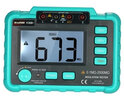I thought that (at least until recently) most RCBOs have only single-pole switching, in which case 'turning off' an RCBO would not prevent potential problems in the case of N-E faults, would it?
It would not stop the leakage but it would stop tripping as a result as the neutral to earth leakage is not going through any RCD device.
A designer can obviously "try" to comply with the 9 mA limit by increasing the number of residual current devices. That could be partially achieved by having one RCBO per circuit but, in the final analysis, in the case of sockets circuits would probably require something approaching "one RCBO per socket"!
Not quite, 3.5 mA is the limit for most things, so at least 3 sockets per circuit, been a while since I have done PAT testing, but seem to remember the leakage allowed was a lot lower, in back of memory seem to remember returning some weighing scales as leakage too high. Seem to remember down to type of filter use.
The isolation transformer is a good point, I have argued many times the reduced low voltage transformer introduces as many dangers as it removes. In the main with no RCD protection and overload protection well over the 16 amp rating of the cable, with a 10 amp fuse on the input at 230 volt a line to earth fault at 55 volt would allow 42 amps to flow. This could easy cause a fire. Not seen a brick yet with protection on the output.
But the 10 mA MK socket we had a work increased the number of trips of the 100 mA and 300 mA trips, as people would press the test button, and it would trip all three every time.
However remember
I traced the fault to an old freezer in the garage
which would likely slowly increase leakage, so it would have a FCU as it says
It soon became obvious that the garage spurs off the ground floor ring.
so to come off the ring would need a fuse, so to swap to a RCD FCU would be an easy job.
But what you need is for back ground leakage to be below 5 mA, as a 30 mA should trip between 15 - 30 mA so if there is over 5 mA leaking then it could still trip the house one first.
The other is knowing it has tripped, my freezer has a light on when powered up, but I tend not to notice lack of a warning light, my emergency touch lights with a power cut, I notice that straight away, so I investigate and turn power back on, luck, and it is luck not design, my touch is on same side of the house to kitchen, so if the kitchen loses power, torch at top of stairs lights.
As you split the home into smaller and smaller circuits, the chance of not realising when the power has tripped increases. I did at one point consider a dedicated circuit for freezers, but that would mean less likely to notice when it trips.
I was surprised how quickly a freezer defrosts. I was in the kitchen when our freezer went bang, it had clearly just stopped, and I had a spare in the garage, so turned on the spare and waited for it to cool down before starting the transfer of food, maybe ¾ hour, when I came to move food, found food at top of freezer had already started to defrost. I would assume it went bang as the motor tried to restart after the defrost cycle, and the heat had risen to top only from the compartment with the cooling bits in, and since no fan running it only affected food at top?
But I was under the impression we had hours to transfer the food. I know I have brought honey ice cream home from Tywyn in a cool box so 70 miles a two hour trip and no signs of melting, so one would not think defrost would be that fast. However experience shows it can be.




